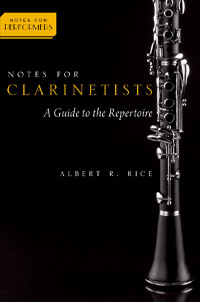 Notes for Clarinetists: A Guide to the Repertoire. Albert R. Rice. New York: Oxford University Press, 2017. Xv, 281 pp. ISBN: 9780190205201. $115.00.
Notes for Clarinetists: A Guide to the Repertoire. Albert R. Rice. New York: Oxford University Press, 2017. Xv, 281 pp. ISBN: 9780190205201. $115.00.
Notes for Clarinetists: A Guide to the Repertoire is the second volume in the series Notes for Performers, edited by Kyle Dzapo. Albert R. Rice is exceptionally well-prepared to author such a volume. His body of publications, notably The Baroque Clarinet (2003) and The Clarinet in the Classical Period (2007), is essential to the scholarly dialogue surrounding the historical development of the clarinet.
The primary goal of Notes for Clarinetists is to provide historical background and theoretical analyses for some of the most performed and studied works in the clarinet literature. Notes for Clarinetists includes thirty-five chapters, each pertaining to a work featuring the clarinet. These are predominantly works scored for solo clarinet, clarinet with piano, or clarinet with orchestra. For each work, Rice presents basic biographical information about the composer, historical details concerning the origins of the composition at hand, the dedicatee and/or the performer for whom the work was written, and details regarding the initial performance. Rice also provides musical analyses with the goal of articulating the harmonic and formal organization of the compositions. Rice sometimes includes performance advice for the clarinetist and tips for tackling technical challenges.
Rice put extensive thought into the selection of the thirty-five works chosen for inclusion in the text. Throughout the selection process, he sought advice from clarinetists and teachers in an effort to accurately select works that are currently “the best known and most often performed pieces in the instrument’s literature” (xii), particularly compositions most often studied by college-level students in the United States. Rice included only one work per composer, as suggested by Dzapo, in order to provide the “broadest selection” of works (vii). While this does allow for the inclusion of a large body of composers, it results in the omission of a few important works, such as Brahms’s Sonata for Clarinet and Piano, op. 120, no. 2. The historical context surrounding this work is discussed in Chapter Six (the entry concerning Brahms’s first clarinet sonata); however, a developed theoretical discussion concerning the second sonata is not included. This omission suggests disregard for the importance of the second sonata in the clarinet repertoire. Regardless, Dzapo acknowledges that the selection of the works is subjective, and she does mention the possibility of future volumes (vii).
While Notes for Clarinetists is primarily intended for undergraduate students taking applied lessons, it would also be an excellent addition to graduate-level courses that are dedicated to providing an overview of the clarinet repertoire. The works are organized alphabetically by the last name of the composer. Although this makes it easy to find specific works, it provides little sense of the chronological development of the clarinet repertoire. For example, the chapter pertaining to Johann Stamitz’s Concerto for Clarinet and Orchestra (1755) is directly followed by Karlheinz Stockhausen’s Der kleine Harlekin für Klarinette (1975). Additional organization may be necessary for instructors intending to deliver the material in conjunction with a chronological overview of the repertoire.
Each entry begins with concise historical background about the composer that, although encyclopedic in style, will suit the needs of undergraduate students who may not be familiar with the numerous composers included in the text. Rice moves on to more focused historical dialogues concerning the work at hand and then provides a theoretical analysis discussing the work’s form and style. Often, Rice uses concise tables and diagrams to indicate details of form and tonality in each movement. His analyses are detailed enough to help the clarinetist understand the work’s overall form without bogging down the reader in excessive detail. Rice has done an excellent job of incorporating previous research, and for every entry he sought out a variety of secondary sources, which he documents clearly, facilitating further study. Furthermore, Rice’s well-documented and well-researched analyses are informed by his experience as a clarinetist. His first-hand experience as a clarinetist and performer (and at one time a student musician) provides a familiarity with the works necessary to inform his voice and guide students towards the most relevant information.
Although this text fills a substantial hole with regard to historical and analytical aspects of clarinet pedagogy, Notes for Clarinetists does have some similarities to the outlines by Norman M. Heim: Clarinet Literature in Outline (2006), The Clarinet Sonata in Outline (2007), and The Clarinet Concerto in Outline (2007). Originally self-published, newer editions of Heim’s outlines have been published by Van Cott Information Services. In these publications, Heim provided a large overview of the clarinet literature, but with extremely brief entries on each work. Heim’s entries are limited to brief composer biographies, the publisher of the score, the original dedicatee, movement titles, and notes about the work’s level of difficulty. Heim organized this information in bullet-points format. It is important to note that the outlines by Heim are outdated and out-of-print and may be difficult to find. Whereas Heim’s outlines are meant only for mere reference, Rice’s Notes for Clarinetists is worthy of serious study. Rice’s book lives up to its name and would be a fine addition to any student, amateur, or professional clarinetist’s personal library.
References
Heim, Norman M. 2006. Clarinet Literature in Outline. Las Vegas: Van Cott Information Services.
———. 2007. The Clarinet Concerto in Outline. Las Vegas: Van Cott Information Services.
———. 2007. The Clarinet Sonata in Outline. Las Vegas: Van Cott Information Services.
Rice, Albert R. 1992. The Baroque Clarinet. New York: Oxford University Press.
———. 2003. The Clarinet in the Classical Period. New York: Oxford University Press.
